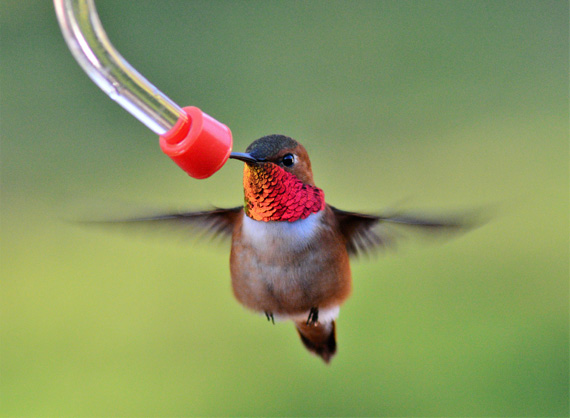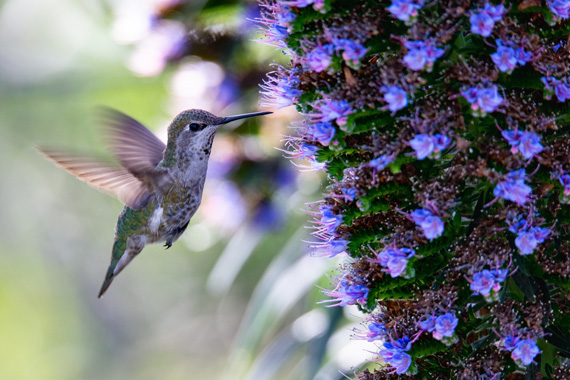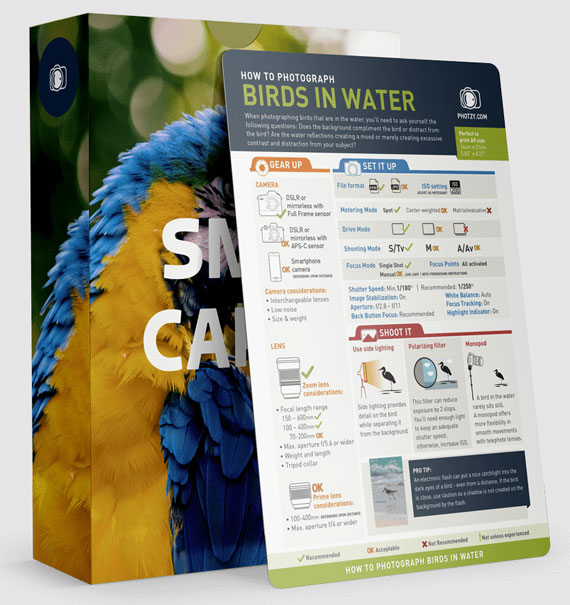Hummingbirds are amazing little birds. They’re the only birds that can fly backwards. They can also fly upside down and sideways. They have beautiful iridescent colors and are almost irresistible to photographers. However, they can be a challenge to photograph. This is article is meant as a guide for beginners when taking pictures of these speedy little birds.

Photo by Bryan Hanson; ISO 2000, f/8, 1/500s
- First of all, you need to know where to find the hummingbirds. If you don’t already have a hummingbird feeder, I would recommend that you buy one. Hummingbirds are very highly attracted to tubular type flowers but may do a “fly by” on different varieties. However, because there is not as much “food” in each flower, they will be darting quickly from flower to flower. If you have a feeder, they will stay in one location much longer. They will get used to that feeder having food all the time and will come and go all day.
- Now you need to position yourself in the right location for the best pictures. Hummingbirds, like any other bird, frighten off easily, but I have found that if you’re very still and wait for a few minutes, they will return to the feeder. I prefer to take pictures of hummingbirds in bright sun. Their feathers have an iridescent color, which just glows in bright sun. Position yourself where you can take pictures while the sun is shining directly on the bird. How close you can get to the birds depends on the type of lens you use. Standing very still, I have had them come within inches of me while I was refilling the feeder.
- There are several pieces of equipment that you’ll need. I would recommend using a zoom or telephoto lens so you can get a good close-up shot without disturbing the birds too much. The farther away you are, the more comfortable they’ll be. I would also recommend using a tripod or monopod. If you don’t have a tripod and your lens has an image stabilizer on it, be sure it’s turned on. You want your picture to be as sharp as possible in case you want to crop it. Using your built-in flash will help to freeze the motion of the wings, however, a hot shoe flash will usually do a better job as they tend to be faster. I personally like to see a little blur of the wings to show motion; to me it’s just a little more interesting.
- Use the auto-focus, AF, setting on your camera. This allows the camera to refocus on the hummingbird as it darts around. This is harder than it sounds, as they’re so fast. Keep an eye on where the bird tends to hover while waiting for another drink. It’s also helpful to use the center AF point for focusing. Try to keep that center point on your subject as much as possible.

Photo by Anchor Lee; ISO 800, f/5.6, 1/500s
- You will also need to use a fast shutter speed, and if in shady light conditions, a higher ISO setting. I recommend a shutter speed of about 1/500 of a second and an ISO that gets you there. If you go too high on either setting in a low light situation, you’re going to get too much “noise” and your picture will look grainy.
- One of the most important things you are going to do to be successful while photographing hummingbirds is to take a lot of pictures! These little speed demons are so fast; you’re going to have to take a lot of pictures to get a few good ones. I have taken as many as 100 pictures, to get 2 or 3 really good shots. Set your camera up so it will take pictures in “bursts.”You can hold down the shutter button and it will take 4-5 pictures, one right after the other.
Hummingbirds are beautiful and amazing creatures. Hummingbird photography is definitely going to be a bit of a challenge, but well worth the effort when you get those one or two great shots.
About the Author:
Sheila Brown (shopbeautifulnaturepictures) is an experienced photographer who enjoys writing articles to share her experiences and her passion for nature photography.
For further training on photographing hummingbirds, here is a helpful video tutorial:
You may not be successful on your first attempt, but don’t give up; with a little time and patience you will succeed!
For Further Help with Bird Photography:
Bird photography is active and hands-on, so your reference materials should be able to come with you anywhere. Enter these new bird photography snap cards. A simple and beautiful way to learn bird photography on-the-go. Download your snap cards – print them out – and pop them in your camera bag— You’ll never miss a shot again! They are currently 82% off today if you want to check them out.
Not only will these Snap Cards give you a simple and beautiful way to learn bird photography on-the-go… They’ll also give you the confidence to experiment. Because now, if you get stuck with a problem, you’ll have the answer right there with you in your camera bag.
Offer ending soon: The Bird Photography Snap Cards at 82% Off
- - - - - - - - - - - - - - - - - - - - - - - - - - - - - - - - - - - - - - - - - - - - - - - - - - - - - - - - - - - - - - - - - - - - - - - - - -
Photography, like any art or skill, thrives on consistency. The journey to becoming an adept photographer is paved with regular practice. Learn how PictureCorrect Insiders can help.
- - - - - - - - - - - - - - - - - - - - - - - - - - - - - - - - - - - - - - - - - - - - - - - - - - - - - - - - - - - - - - - - - - - - - - - - - -
This post How to Photograph Hummingbirds appeared on PictureCorrect.
from PictureCorrect https://ift.tt/nfo6AXm
via IFTTT







0 kommenttia:
Lähetä kommentti